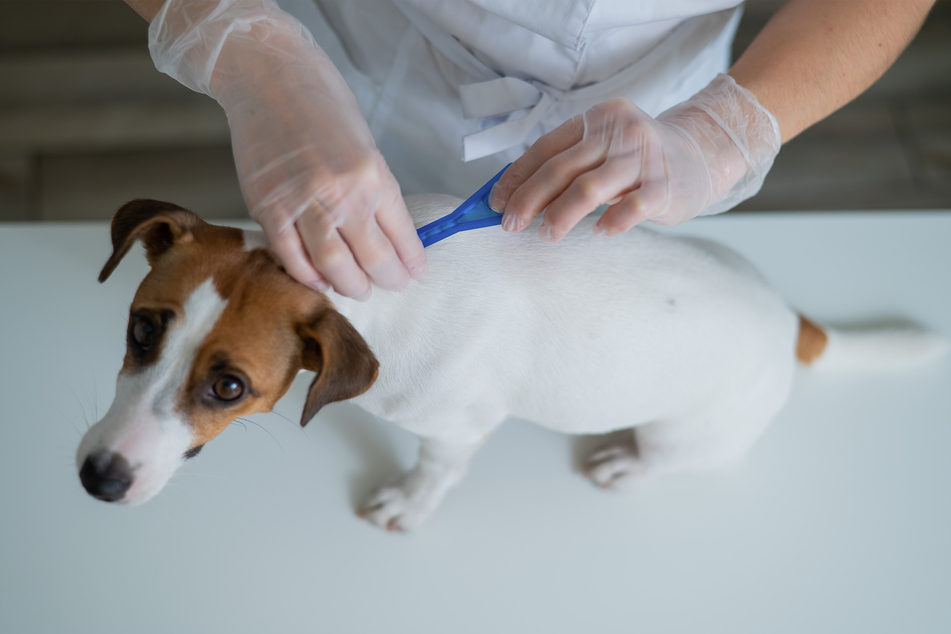Ticks on dogs: Symptoms, treatments, and everything you need to know
When ticks bite dogs, things can end badly. As a result, it's important for every dog owner to learn how to recognize a bite. What are the symptoms and what treatments are available? Let's find out!

There are few creatures in the world more nasty and dangerous than the tick, packed full of the potential for horrific diseases and nasty infections.
While we humans will instantly recognize if we get bitten by a tick, dogs are a little different. The problem is, these tiny little parasites are just as dangerous for our canine companions as they are for us – so what can you do to protect your pooch?
TAG24's dog guide has the answers you're looking for when it comes to ticks on dogs!
What are the symptoms of tick bites on dogs, what treatments are available, how do you recognize and check for bites, and what else do you need to know? Read on!
Symptoms of tick bites on dogs
Ticks have very distinctive and nasty symptoms when they attack dogs. These signs can range from relatively benign, like a slight change in your pup's bark, to more serious symptoms that include paralysis and difficulty breathing. In extreme circumstances, tick bites can actually cause death, so it's incredibly important to be able to recognize the early symptoms and signs.
Here are the most common tick bite symptoms in dogs:
- Slight, or even major changes in the tone and sound of your dog's bark
- Severe and continuous vomiting
- Loss of coordination and wobbliness, especially in the hind legs
- Persistent coughing
- Dehydration
- Lack of appetite
- Dry retching
- Constant panting and rapid breathing
- Lethargic behavior, a sense of severe tired
- Irritation of the skin
- Anemia
- More extreme symptoms include:
- Paralysis
- Difficulty breathing
- Death
Important: If your dog experiences any of these symptoms and you suspect or find a tick bite, you must immediately take your doggo to the vet. While we will provide a few basic tips on how to look after your perfect pooch in this situation, it will need medical attention as soon as possible.
Do dog ticks carry Lyme disease?
The ticks that attack your dogs rarely transmit Lyme disease, though they can still make humans very sick if transferred. While most people will be okay if a tick from their dog transfers over to them, the parasite will neither give you nor your pup this most awful and dangerous of diseases. The more likely result of a dog tick bite is some kind of spotted fever or tularemia.
What diseases do dog ticks carry?
There are a vast assortment of potential diseases that can be transmitted by dog ticks, many of them dangerous and potentially deadly. While we won't go into the details of each disease here, you can find an exhaustive breakdown on the CDC website. In the case of health, it's always best to resort to a proper authority and get a doctor's advice if you're concerned.
The diseases transmitted by ticks include the following:
- Tularemia
- Anaplasmosis
- Babesiosis
- Lyme Disease
- Borrelia Mayonii
- Bourbon Virus
- Colorado Tick Fever
- Ehrlichiosis
- Heartland Virus
- Powassan Disease
- Rocky Mountain Spotted Fever
- Tickborne Relapsing Fever
This is not an exhaustive list of potential tick borne diseases. These are just the most common in US and there are many, many more out there. If you have been bitten by a tick and are worried about your health, see a doctor as quickly as possible.
Many of these pathogens will attack you but not your dog if bitten. In much the same way, there are pathogens that will attack your dog but not you. This is part of what makes a tick bite scary, you never know what might happen.

Dog ticks treatment
The best dog tick treatments will always come from your veterinarian and, as a result, a professional should be the first port of call in the event of a bite. With that in mind, there are a few things worth talking about when it comes to treatment for ticks on dogs, as well as preventative measures.
Here are a few dog tick treatments to think about
Go to the veterinarian: Your vet is an animal medical professional and will know what to do in the event of a tick bite. They'll be able to check for any diseases that may have been treated, they'll be able to address any symptoms, and they will be able to stave off any serious problems.
Tick collars: Tick collars are used to kill the parasites before they have a chance to bite and transmit diseases into your dog's blood stream. They generally use a chemical made up of tick-killing ingredients that then spread across the dog's coat. It's a good alternative to monthly treatments.
On-the-spot treatments: There are various products that can be bought in most pet shops that'll be able to slow down infections and reduce the risk of disease transmission if you catch the tick early. In most cases, they come in the form of creams and rubs that are applied to the bit area after you have removed the tick.
Anti-tick medication: Usually applicable against fleas as well, these medications generally get prescribed on a monthly basis and are applied to the back of your dog's neck. They work in more-or-less the same way as tick collars, and are compulsory in many states and countries.
Prevention: The best treatment for any illness or affliction is always a preventative one. By reducing the risk and stopping the issue from happening in the first place, you mitigate all potential harms.
Here are some recommended prevention strategies:
- Regularly check your dog for ticks (described below)
- Remove all ticks from your dog when they get found (described below)
- Make sure there are no ticks in your yard
- Avoid tick-heavy areas when you walk your dog
- Don't allow your dog off the leash when in areas that may contain ticks
- Keep your dog's monthly treatments up-to-date
- Tick prevention products (at the discretion and advisement of a vet)
- Follow all stated CDC guidelines.
This is one of those situations where prevention is super important. In many cases, treatments can be limited for tick bites on dogs - as a result, make sure to check regularly.
Important: There is also an incredibly useful fact sheet issued by the FDA on various flea and tick products that work really well. It also includes crucial information on how those products impact on your dog's health in other ways.
How to check dogs for ticks

While your veterinarian should be where you go for all treatments and advice after your dog has been bitten by a tick, one of the biggest responsibilities of a dog owner in a tick-prone area is to regularly check for bites. It's not a difficult task, but it is one that can be time-consuming. Still, it's better to waste your time looking for nonexistent ticks than to let one go unnoticed.
Here's how to check your dog for tick bites
Step 1: After a walk, calm your dog down with a nice cuddle and a treat or two. Make sure that your dog is comfortable, then go in for a search.
Step 2: Ticks will look like tiny black bumps on your dog's skin, as they burrow in and leave their rear ends sticking out of the surface.
Step 3: To find them, carefully pull apart your dog's fur so that you can see its skin. Doing this while brushing your dog after a bath is very, very effective.
Step 4: There's not much to it, really, you just need to slowly go over their fur, pulling it apart so that you can see its skin and check it for black lumps.
There are a selection of areas on your dog's body that are most likely to be bitten by a tick. They include the following:
- Inside their ears, or in the surrounding area
- Around your dog's eyes
- On the tail
- On the bum
- Between the back legs, on the thighs
- Your dog's feet, especially between the toes
- Under your doggo's collar and around the neck
- On the chest and underneath the front legs
Try to check your dog for ticks at least once a week, even if you live in an area that's relatively tick-free. In more tick-prone areas, check your pup after every walk.
How to remove ticks from dogs at home
Removing ticks from a dog is a somewhat difficult process and will require a bit of practice. If you get it wrong you could break the tick's body, leaving part of the parasite inside your dog's skin. This can then result in severe infections and various other health issues, as well as a lot of pain.
With that in mind, here's how to remove a tick from your dog
Step 1: Get yourself a comfortable, fine but blunt pair of tweezers that you can use on your dog and that won't slip from your fingers. They should have very thin ends, to improve accuracy and avoid crushing, but shouldn't be sharp.
Step 2: Spread your dog's fur at the bite location and take a look at the tick. If it is poking high enough out from your dog's skin, move on to the next step. In the case that it's not, don't attempt to remove it and instead take your dog immediately to the veterinarian.
Step 3: If possible, grasp the tick as close to your dog's skin as possible with the pair of tweezers. Be extremely gentle when you old it, only applying enough force to have a grip but never enough to crush or break the tick's body.
Step 4: In one gentle and slow motion, keeping everything extremely still and steady, pull the tick out. Do this in a straight direction, pulling it directly out twisting or squeezing it in any way.
Step 5: Apply a vet approved antiseptic to the wound and a small doggy band-aid to avoid it getting scratched and infected.
There are a variety of tick removal products that can make this whole process a lot easier. Things like the tick hook or even the tick tornado and tick stick can be very useful, but in most cases a pair of tweezers will suffice.
Make sure to still take your dog to the vet even if you've managed to remove the tick. The parasite could have still done damage and transferred diseases into your canine companion's bloodstream, so it's best to be safe.

I found a tick on my dog, should I be worried?
Tick bites are a serious business, especially when they're on a dog or cat. To these small and beautiful animals, these nasty parasites can be deadly. As such, if your dog is bitten by a tick then it should be immediately taken to a vet and given whatever treatment that it needs. While home remedies can help in the short-term, it's better to be safe than sorry.
Ultimately, though, you shouldn't get too worried. Doggos get tick bites all the time, and most of them end up fine. Get medical attention quickly, stay calm and focused, and everything will be okay.
Cover photo: IMAGO/Pond5 Images





